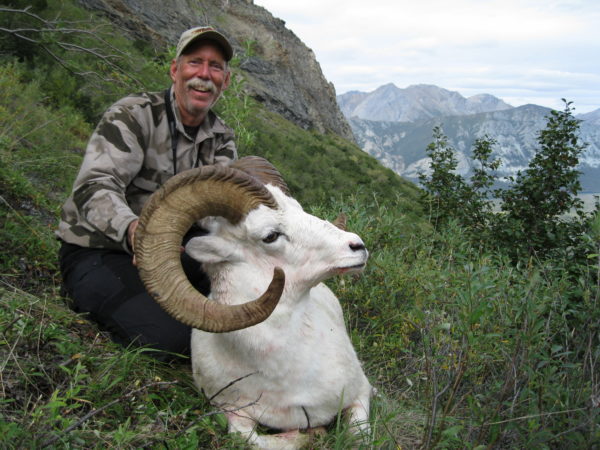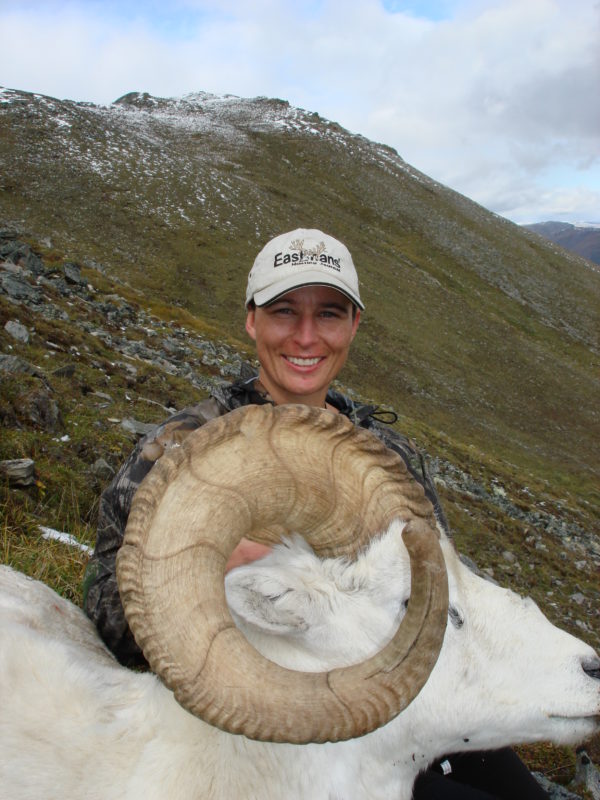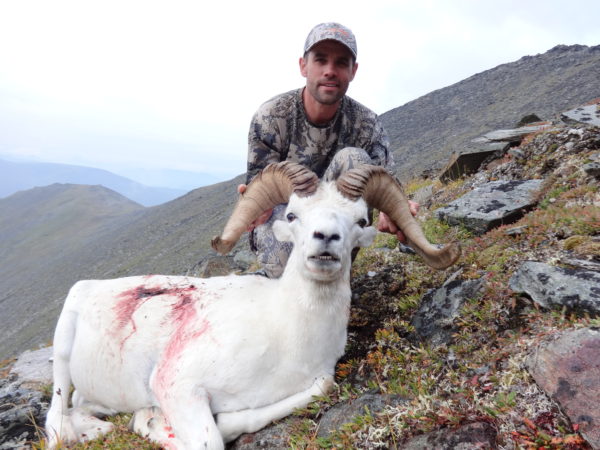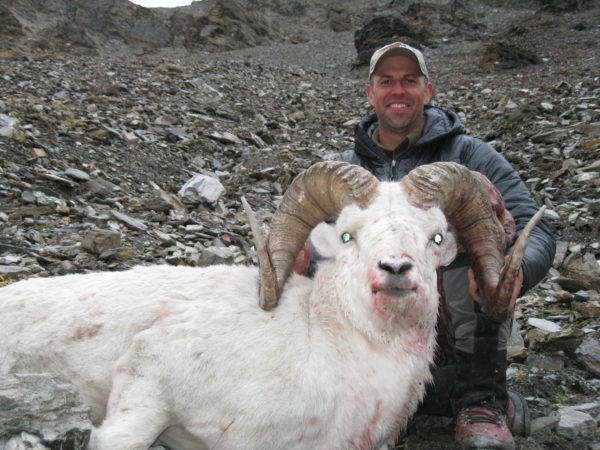
There is no such thing as an easy Dall sheep hunt. Every time you head into the northern mountains for these white sheep, you are in for a grueling high-country adventure.
Sheep hunting tests all of your skills: camping, orienteering, alpine trekking, stalking, and above all else, physical endurance. Sheep hunting also tests your gear. If you spend ten days backpacking after these elusive and high-climbing ghosts, you’ll find yourself full of fresh opinions about backpacks, tents, footwear, and apparel. Because there’s an undeniable link between gear performance and personal performance when you’re living in such an abusive environment, Dall sheep hunters are among the least apologetic gear freaks in the world. No wonder that there’s a small industry of manufacturers who make “sheep gear,” basically ultra-lightweight and ultra-durable hunting products.
Some hunters look at the cost of this stuff and come away feeling that sheep hunting is nothing but a rich man’s game. Don’t make this mistake. If you’ve got the necessary drive and devotion, you can head into sheep country with your usual hunting kit supplemented by a few items that can easily be found used on Craigslist or eBay. And if the costs of a sheep tag or a guided hunt are beyond your means, consider joining up with another hunter on his adventure. By the end of the trip, neither of you will care who actually pulled the trigger. When two sheep hunters come off the mountain with one animal, there’s no such thing as “my sheep.” It’s “our sheep.”
Scientific Name
Ovis dalli
A.K.A.
Thin-horned sheep. At the southern extreme of the Dall sheep’s range, the animals are colored grayish-brown. These are commonly known as stone sheep, though taxonomically speaking they are still Ovis dalli. Fannin sheep are another color phase of Ovis dalli. They occupy the middle ground (both in color and geographical distribution) between the white-phase Dall sheep and the gray-phase stone sheep.
Bar Room Banter
Dall sheep and bighorn sheep both share a common genetic ancestor that migrated from Siberia to Alaska sometime during a glacial epic when sea levels were low enough to expose the Bering Land Bridge. At a time, it’s likely that one single species of mountain sheep ranged all the way from Northwest Russia eastward and southward through Alaska and into the Rocky Mountains of the lower-48. Eventually, a number of barriers arose that blocked genetic exchange among these populations and allowed for the development of three distinct species: Siberian snow sheep, Dall sheep, and bighorn sheep. It seems likely that massive glacial ice sheets were responsible for the separation between bighorn and Dall sheep. Today, the gap between the ranges of these two species’ is still mostly consistent with the placement of ice sheets during the last glacial epic.
Physical Characteristics
White, with sometimes yellow or “dirty” casting. See A.K.A. section, above, for color variations. Males carry magnificent and highly conspicuous curved horns that measure up to 40” long. The horns of ewes, or females, resemble a barnyard goat’s. Males can weigh well over 200 pounds. Females, about half of that.
Diet
Primarily grasses, sedges, and forbs, with fescue and saxifrage being among their favorites. Dall sheep will also eat horsetail and the shoots and buds of willow.
Life and Death
Wolves kill a lot of Dall sheep. The sheep are also preyed upon by wolverines, lynx, bears, and golden eagles. The latter can catch the lambs by simply nabbing them or toppling them over cliff faces. Avalanches are another common killer of Dall sheep. As for life expectancy, a 12-year-old ram is quite old. Very few females live beyond 14 years.
Breeding and Reproduction
Dall sheep rut in late October and November. Ewes will drop one lamb in May.
Habitat
Rocky, precipitous terrain, usually above treeline. Frequently found in glaciated terrain toward the heads of river drainages.
Edibility
Superb, one of the absolute best. Suitable for all red meat applications.
Hunting Opportunities
Unless you’re a resident of Alaska, British Columbia, the Yukon, or the Northwest Territories , or have an immediate family member in one of those places , you’ll have to hire a guide to go Dall sheep hunting. Bargain prices start at $12,000, but most hunts will cost you closer to $20,000 and the top end goes near $30,000. For many people, the best way to experience a Dall sheep hunt is to join another hunter as a packer and helper. It’s cheap, and just as fun as being the guy who pulls the trigger.
Hunting Methods
When you’re traveling in good sheep country, it’s common to see at least some Dall sheep every day. However, finding a ram that’s large enough to be legally harvested can be extremely challenging. In some areas, legal rams account for less than 10% of the total sheep population. These legal rams can be the hardest to find, too, because they like to hang out in the highest, least hospitable, and most difficult to reach portions of their mountain homes. Many hunters return from ten-day sheep hunts having seen dozens of rams but not a single “full curler.”
Defining a Legal Ram

To seriously hunt Dall sheep, you need to be willing to cover massive amounts of ground in search of legal rams. Eight miles a day isn’t unusual, and twice as many miles a day isn’t unheard of. And sheep country is hardly flat. You’re likely to gain and lose thousands of feet of elevation every day. Multiply these distances and elevation changes by the seven to ten days you plan on hunting, then add on the additional five or ten miles that it takes to reach sheep country from lower-altitude landing strips used by bush planes, and you’ll begin to see the importance of being in rock hard physical condition before you commit to a Dall hunt.
What enables sheep hunters to travel so widely, beyond being in good shape, is that Dall sheep are fairly easy to see. The title of Alaskan outfitter Rick French’s Dall sheep hunting video, Black Shale, White Sheep, really says it all. Thanks to their color, you can typically rule out the presence of the animals in those areas where you don’t see them after an initial inspection. Thus it’s possible that you might glass six or seven miles of a drainage in a single day, along with the basins of as many tributaries, without feeling that you overlooked something obvious. (Compare this to whitetail deer hunting, where you can stare at the same patch of brush for five days and still not see half the deer that are hiding in it.) When you wake up in the morning on a sheep hunt, you’re not thinking about backtracking for a second look. You’re thinking about what lies over the next ridge.
Don’t take this to mean that you can be lazy about glassing. You still need to give the landscape a careful looking over. Rams are often found in the large cirques or bowl-like basins at the absolute heads of drainages. They like to bed in areas where they’ve got escape cover to their backs, often in the form of steep and broken cliff faces. When the sun’s behind them, these cliffs cast shadows that are difficult to penetrate with optics at a long distance. Make sure to check them carefully. Rams also like to bed along the crests of finger ridges just below their junction with the primary ridgeline. Large boulders and jumbles of rock can obscure these sheep. Pick these areas apart with great care. And keep in mind that you might just see a white leg poking out in the sunshine from behind a shaded rock, or a curved section of horn jutting out from the side of a rock jumble. If you do get into a situation where you can’t rule out the presence of a ram, it’s a good idea to glass the area in the evening.
The rams will get up then and move around. Should it snow, your job just got tough. Dall sheep have a yellowish or “dirty” cast that makes them stand out against the snow a little bit, but not too much. Rather than just looking for sheep in the snow, you want to look for sets of tracks as well. These appear at a distance as lines that seem to be etched into the mountainsides or running up the crests of finger ridges. Follow these lines both ways. Sometimes the tracks will mysteriously vanish. As you try to figure out where the animal went to next, you’ll realize that the trail ended simply because you’re looking at the sheep that made it.
Try not to get bogged down with a fixed campsite when hunting Dall sheep. Remember, mobility and flexibility are key. Countless Dall sheep have been killed by hunters who ended up 20 or more miles as the crow flies from where the bush plane dropped them off. Carry what you need, and only what you need. Sleep wherever you happen to be when the day is done. And when you do stop for the night, pick a place where you can see a lot of the surrounding country.
Dall sheep are typically hunted in late August and September. You can’t possibly hunt from dawn to dusk during the early season, because at those latitudes there are only a few hours of dark. It’s nice if you can keep glassing while you cook and do whatever chores need to be done before you start hoofing it up and down the mountains the next day. After all, it’s next to impossible to enjoy all the climbing that a Dall sheep hunt involves. But the sights that you’ll see in sheep country make all the blisters and strained ligaments seem like a very small price to pay.
Rick French, an Alaska Sheep Guide, Weighs in on the Dos and Don’ts of Hunting Dall Sheep
Do
- Do stay out of sight. If you can’t see them, they can’t see you. If possible, it’s okay to occasionally check on the sheep to ensure circumstances haven’t changed. Then get back out of sight and continue on.
- Do take the high road. Sheep tend to look down rather than up. Get above them and you have turned the tables to your favor.
- Do cover your face and hands with a head net and gloves when within shooting range or when you’re peeking over a ridge. Human skin reflects a lot of light, especially when it’s oily and sweaty. By covering up you are much less likely to cause alarm if a sheep happens to spot you at close range.
- Do pay attention to wind, and think ahead to what thermals will be doing later in the day. Example: If you’re above a ram in the morning and you have to descend the mountain for a shot, let the thermals change to their uphill direction before you start your stalk.
- Do use the best optics you can afford. Determining that a ram on the next mountain is actually sub-legal could save you a day of pointless hiking and thereby earn you a day of looking for legal rams.
Don’t
- Don’t let them see you first. If they do, it’s typically game over.
- Don’t stalk them from below if you can prevent it. Most times, coming from below will put the odds in the sheep’s favor.
- Don’t worry too much about kicking a rock or two lose. Sheep are accustomed to rocks falling. Simply stand still for a few minutes and then quietly begin your stalk again.
- Don’t be lazy. If you want to take a short cut where a ram may see you crossing open country in order to save a couple hours of walking, don’t do it. Always go the long way, if that’s where you’ll find cover. A little extra hard work will pay big dividends.
- Don’t go on a sheep hunt without a SPOT emergency locator or a satellite phone. These tools can literally save lives if you or your partner gets injured.








Conversation